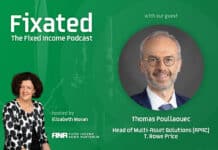
Last week I interviewed Darren Wills, BlackRock’s APAC Head of Fixed Income in iShares and Institutional Index Investments. Darren shares much in this interview including his strategic asset allocation views, the case for using fixed-income ETFs alongside direct investment and current market themes and trends.
Darren Wills – Thinking about the fixed income market, we believe that inflation’s probably still going to be more persistent than the market expects and to bring inflation back down to a 2% target is going to be incredibly hard. And getting to below 3% to the target of 2%, will require significant economic contraction in the US.

While the market is thinking about a pivot, we think the Fed might pause when they see the economic effect of the hikes that they’ve already done but we don’t necessarily see them easing anytime soon. So, we think rates will be higher, but they will be higher for longer.
We think inflation due to structural factors in the global economy, is likely to be higher for longer. Therefore, how does that move into fixed income?
Well, generally longer-dated government bond rates, on balance, due to that higher inflation going forward, rates should be higher and investors should be paid more for taking on that term risk. But the majority of the move has happened. So, therefore, where do we see the attractive part of the market at the moment?
Also read: A Global Asset Allocation View
Short duration, fixed income looks attractive in our mind, especially short duration investment grade credit. I mean, I think we’ve moved a long way from a world where at the short end you could get zero. At the longer end investment grade credit you were looking at 1.5%. Even in global high yield 12 months ago, you were looking at 3 to 4%. The world has materially changed.
In the Australian market, you can now get 5% in short-dated, investment-grade, fixed income, which we think looks attractive. And we think based on the shape of the curves at the moment, with perhaps the market overthinking what central banks might do during this hiking cycle, we actually think that the short end looks attractive versus the long end because you’re not getting paid for taking that additional interest rate risk.
Elizabeth Moran – And especially, if you think interest rates are still going to go higher, why would you invest in that part of the curve? You’d avoid it.
Darren Wills – This moves on to how we are seeing investors increasingly using fixed income ETFs and that’s for precision. One of the stories that we are seeing pan out globally is that investors are potentially shifting from more broad-based fixed income exposures, which have worked over the past 10 years as rates have come down globally and are moving towards more precision instruments to use within their portfolio. And I can give you a couple of examples.
So the AusBond Composite Index is a great index. It’s very balanced, it is still quite long duration and it’s low credit spread. So, it’s pretty much a rates product. Now, if you are still quite aggressive in your equity portfolio, then yes, having some longer duration assets in there makes sense because rates have risen to the effect that if we do see some kind of prolonged economic downturn, if we do see a deep recession and central banks have to go back into easing mode, then you should see that negative correlation come back into longer date fixed income that we haven’t seen during this hiking cycle.
But rates have moved up from those lower bounds. So now we do think that they will provide potentially in a very protracted downturn, they should provide that diversification. So, if you still risk going in your equity book, we think it makes sense to potentially add back some longer-duration assets.
If you are more cautious in your growth part of your portfolio looking from a multi-asset lens, then you don’t really need as much of that long-duration asset. So, we think in your fixed income portfolio, you’re more likely to take advantage of those short-end yields and not take on that additional interest rate risk if you don’t need to.
Also read: Australian Social Housing Bond Report
The story is relatively similar if you look at global flows and you look at the flows into Australian fixed income ETFs. People are moving away from higher risk, longer-duration assets into more precision tools. Whether that’s looking at inflation link bonds versus nominal bonds.
Then again, one of our views at the moment is that we prefer credit over equities, especially on the investment grade side. We think given the recent backup in spreads and the fact that we’re not at the end of a typical cycle, we think that the investment grade part of the market based on attractive spreads and based on the possibility of a downturn, we don’t see that being a severe default cycle. We think investment-grade credit spreads are looking quite attractive.
The story here is going from kind of broad exposures that have worked over the past 10 years or so to investors being a lot more selective then looking at different parts of the fixed income market to target the exposure they want in a very precise way.
Elizabeth Moran – That’s excellent. Are you seeing that same story in your funds flows?
Darren Wills – Absolutely. That is one of the stories this year, first, I’ll talk on a global basis first and then how that relates to Australia. We’ve seen hundreds of billions of dollars actually flow out of traditional mutual funds globally into fixed income ETFs. The numbers look like about minus US$400 billion out of traditional active mutual funds and plus US$200 billion into fixed income ETFs. And while a lot of people would like to make that story a continuation of the active versus index story, it’s not about that, it’s a precision versus blunt instrument story.
In terms of ETF flows, what we’ve seen on a global basis is people, going up in quality, given the rising yields, as you don’t need to take on as much risk to get the yield that you want or the income that you want in your portfolio. And from longer duration, generally speaking to shorter duration assets. So, we’ve seen a large amount of money coming back into the US treasury market and a large amount of money coming back into the short end of the curve where again, you were talking about very low single-digit percentages even 12 months ago and now you’re talking about being able to generate 5- 6% for very little interest rate risk and high quality credit risk. So that’s looking attractive to a lot of people given the current environment.
That same story feeds through to Australia but the numbers are smaller, However, the growth in fixed income ETFs is still well above the average that you’d see globally. Investors are being more deliberate and more precise about how they are constructing portfolios.
Elizabeth Moran – Okay, fantastic. One thing I was interested in exploring, a lot of our audience are financial advisors. If you were speaking to a group of financial advisors, why should they prefer BlackRock instead of your competitors?
Darren Wills – I’m not going to talk about our competitors, but I will talk about our products. Out of those US$200 billion of flows into fixed income ETFs this year, iShares share was over US$100 billion of that. And we are the clear market leader globally in fixed income ETFs. We have the broadest product range, we have a track record of delivering against those benchmarks in a very efficient and effective way. And actually, we spend a lot of time also thinking about that whole client experience in terms of the market trading and ecosystem. So, I would say you could take a mutual fund and list it on exchange and you can call it fixed income ETF, but actually we spend a lot of time and resources actually making sure that listing on the exchange actually offers clients additional benefits. And I’ll give you an example.
In our high yield ETFs, the underlying market trades perhaps 50 or 60 basis points wide if you want to go out and trade the underlying bonds. But what we do is we talk a lot to institutional investors such as pension funds, asset owners, such as insurers, central banks, official institutions who use our products alongside traditional wealth and retail clients. And what that means is all types of investors are able to use this instrument to construct portfolios on the wealth and advisor side or to make tactical changes to their portfolios on the institutional side. And those investors all trading the same instrument means that some volume or a decent proportion of volume will go through where investors can transfer risk of the ETF level without necessarily having to buy or sell bonds every time that invest the trades, which is very much unlike a traditional mutual fund.
So, that means on the ETF side we’re actually democratizing the fixed income market to some extent. We’ve given investors the options to move around the fixed income markets, whether that be high yield or emerging markets, adjusting their duration, inflation-linked bonds versus nominal bonds in exactly the same way as traditional sophisticated investors such as active investment managers or other institutional investors have traditionally done. And all of these investors meeting together on an exchange. It’s very transparent pricing. You can see where trades are going through, you can see where the liquidity is, and that’s giving investors confidence to actually move risk in what is sometimes very challenging market conditions. Also, at bid/ask spreads that can, not always, but can at times be considerably lower than what you would find if you trade traditional mutual funds or you actually trade the underlying bond markets themselves.
So, there are a set of tools that we’ve been working on over a number of different years and we’re very pleased to see the growth in adoption, not only from those institutional investors but from wealth and retail investors alongside advisors at the same time.
Elizabeth Moran – Okay, can you talk a little bit about your product range, like the range of the diversity of your ETFs and perhaps if you are thinking about bringing any new products to market?
Darren Wills – Yes, I can talk about the current range. We have a very broad product range in Australia. We believe it’s very competitively priced and we do have a broad range.
We do offer exposures to different parts of the fixed income market, such the inflation link side, the government bond side. Investors still might want that broad exposure at the core part of that portfolio. We offer that as well. And we do offer a number of short-dated solutions. I think we are also one of the few houses that offer exposure to global parts of the market as well, such as global investment grade, global high yield in your traditional exposure such as global ag. So, we believe we’ve got a fairly good and broad range, one of the biggest ranges as it currently stands.
We are always looking to work with our clients to offer them access to more parts of the market and into new exposures. We’re in consistent dialogue with clients and we all say, look, try and take a forward-looking view of the market and think what will investors need to construct portfolios going forward. There are definitely areas that we’re looking at at the moment. Obviously, I can’t say too much about that, but yes, it’s a continually evolving landscape and we will definitely look to keep innovating and bring more products to market to satisfy that demand from our clients.
Elizabeth Moran – One last question Darren, I didn’t talk about the preference for fixed versus floating. If you prefer short-dated securities, are you largely indifferent between those two options?
Darren Wills – Yes, I think so. And again, this is just like any decision, this is all about time horizon. I mean, I can remember having a similar conversation with an investor. He said, “I thought government bonds were a defensive place to put my money in the market. How have I lost 15%?” And the answer is that’s from a default risk perspective. So, we have no doubt that if you invest in high-quality government bonds such as Australia, that you’re going to get your money back at the end. But in the meantime, you are exposed to a lot of interest rate risk, which is obviously the reason that we’ve seen the drawdown. When you look at short-dated then, yes, I mean depending on how far you go out on the floating rate note side, for short duration, fixed income, then up to one year, potentially up to a couple of years in duration, it’s very much like floating rate right now anyway because there’s low sensitivity to any interest rate rises.
One thing to obviously be careful about on the floating rate note side is even though the interest rate sensitivity’s very low, generally three months in nature, depending on the overall maturity of the floating rate note, you are potentially taking on higher spread duration or sensitivity to credit spreads. And it’s that part that if credit spreads were to widen, then obviously even though you’re in a low sensitivity to interest rates, you do have generally a higher sensitivity to credit spreads. So that’s something to be aware of. But yes, I mean short-dated zero to one, zero to three, again, bonds nearing maturity do pull to par $100 value quite effectively. But again, on a shorter term, if the RBA, for example, was to surprise the market and be far more hawkish than they’ve been in their recent meetings, then yes, there will be some sensitivity to that, but much lower.
Elizabeth Moran – Is there anything else you’d like to say or comment on to our readers?
Darren Wills – We are obviously delighted with the growth in the Australian market in terms of using instruments such as ETFs to construct portfolios. I mean, I think that regulatory drive, which started potentially in Europe, moved to the US and has come to Australia as well in terms of moving to a fee-based advisory structure for a lot of the wealth advisor market increase use of models to get that scale. The use of fixed income ETFs and in fact other index instruments is happening in a similar way, too. It’s happening across the rest of the world in terms of people being very more deliberate, looking at outcomes first, being very careful about their asset allocation, and then using the best instrument to implement that view.
We see investors blending active and index investing to come out with the best outcomes for their clients. And as a house that offers both, we think that’s exactly the right way that whether it’s advisors or investors should be thinking about implementing their strategic asset allocation or tactical asset allocation views. That makes complete sense to us.

































